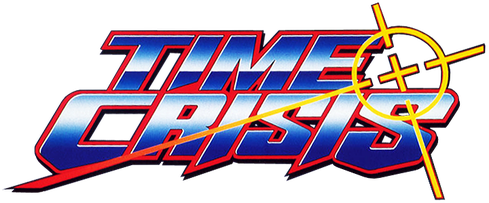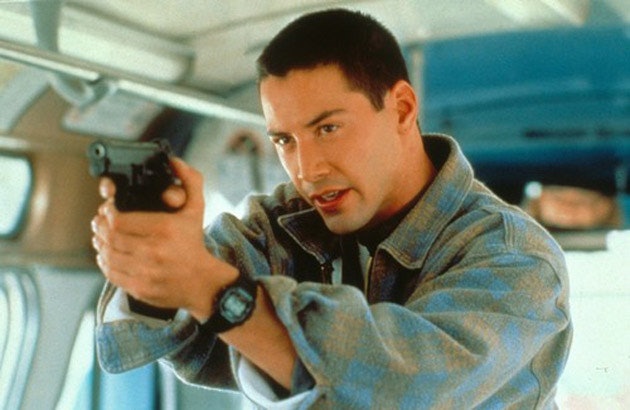Heavy
Banned
LIGHTS! CAMERA! ACTION… RELOAD!
Alternate History Pop Culture Vignette
Alternate History Pop Culture Vignette
Sometime, somewhere, someone is plotting a government overthrow…
A small republic is in danger…
It’s time for the one-man army…

TIME CRISIS: THE MOVIE
1999
A small republic is in danger…
It’s time for the one-man army…

TIME CRISIS: THE MOVIE
1999
Namco’s light gun rail-shooter Time Crisis made its triumphant arrival in North American arcades in late 1995, rapidly becoming a major success, and received a PlayStation port two years later which repeated the success of the arcade release. Before long, the property was optioned by Sony Pictures, the American filmmaking subsidiary of the Japanese conglomerate which also owned the PlayStation console, for a major Hollywood film. Superstar producer and noted video game fan Jerry Bruckheimer, fresh off a string of highly successful big-budget action blockbusters was soon hired to pilot the project to its mooted release date in the summer of 1999. Time Crisis, most agreed, was something of a blank slate, its plot an excuse to play the part of an action hero in the first person, but this was regarded as a mark in its favour; an indication of its potential as a major action franchise.
Although it was far from the first attempt to adapt a major video game franchise to the silver screen, few of the preceding efforts had enjoyed great success; only Street Fighter and Mortal Kombat could be described as box office hits even though neither had earned many favourable critical notices. However, Time Crisis was viewed with optimism by both Bruckheimer, whose stated belief was that video games and films would eventually become indistinguishable, and Namco, who noted the cinematic qualities of the game and particularly the influence of Hollywood tentpole action movies, especially the Die Hard trilogy, on its production. The most confident backers of the project hoped that it could produce a new action franchise to rival the evergreen James Bond film series, which Sony had spent much of the past decade working hard to acquire from MGM without success.
Sparing no expense, Sony allocated a respectable $50 million budget and hired screenwriter Jonathan Hensleigh to write a screenplay for the film; Hensleigh’s resume included a several successful action and adventure films (several of which had been Bruckheimer productions) including Die Hard with a Vengeance, Jumanji, The Saint and the Michael Bay-directed disaster film Armageddon, which was released shortly after Time Crisis entered principal photography and became the highest-grossing movie of 1998.
Hensleigh’s Time Crisis script followed the barebones storyline of the game closely: Sherudo Garo, a deposed tyrant and Wild Dog, his terrorist-for-hire henchman, kidnap Rachel McPherson, the daughter of the president of the fictional nation of Sercia, and hold her to ransom in an island castle in exchange for the restoration of the royal family; in response, the international intelligence agency V.S.S.E. dispatches its most skilled agent, Richard Miller, to infiltrate the castle and defeat the villain’s plot. At the same time, Hensleigh’s script took some liberties with the premise and plot, adding some extra characterisation and filling out some plot details, including the elaboration of a history and rivalry (only alluded to in the game’s instruction manual) between the protagonist Miller and Wild Dog and the addition of a subplot intended to make Rachel seem “like less of a damsel-in-distress” (critics would notably prove divided on how successfully this objective was achieved).
Initially, Bay was also tapped as Bruckheimer’s first choice to direct Time Crisis, but he had already been hired by Disney to commence pre-production on the war epic Pearl Harbour and was unavailable. Bruckheimer turned instead to experienced action director John McTiernan of Predator and Die Hard fame; with several projects on the table to choose from, McTiernan would turn down a request from James Bond star Pierce Brosnan to direct a new version of The Thomas Crown Affair in favour of Time Crisis (Tony Scott would subsequently direct the Thomas Crown remake). He would contribute his own ideas, primarily several key action set-pieces including a dramatic scene in which Miller abseils from an exploding tower, to Hensleigh’s script during pre-production, and is believed to have hired an uncredited script doctor (widely reputed but unconfirmed to be Carrie Fisher) later made several further amendments to “punch up” the dialogue.
Several actors were considered for the lead role of V.S.S.E. agent and “one-man army” Richard Miller, including “traditional” action stars Arnold Schwarzenegger, Jean Claude Van Damme and Sylvester Stallone, although all were judged too old for the role. Tom Cruise, then one of Hollywood’s most bankable stars and whose action pedigree had been proved by his big-screen reboot of the Mission: Impossible franchise three years earlier, was reportedly interested but eventually opted out, expressing dissatisfaction with the early draft of the script he had been shown. Instead, Keanu Reeves would be cast, with McTiernan citing the actor’s athleticism and focused intensity as decisive factors in his selection. Reeves’s performance as Jack Traven in Speed (1994), which the actor acknowledged in interviews was a similar role to Miller, earned him the support of producer Bruckheimer and Sony Pictures. Reeves had also been under consideration for another action movie released that year – the lead role of Neo in the Wachowskis’ science-fiction martial arts actioner The Matrix – but only as a fall back choice in the event that their first choice, Will Smith, declined the part, which he did not.

The female leading role, Rachel McPherson, daughter of the president of Sercia, went to Natalie Portman, who had made her feature debut in another major action film, Luc Besson’s Léon: The Professional, only five years earlier at the age of 13. Portman had at one time been considered by George Lucas to play the female lead in the first Star Wars prequel, but was narrowly beaten out by English actress Keira Knightley. Although reluctant to take what she felt was a “passive” minor part, Portman was persuaded when informed of the expanded role introduced for the character in the script, commenting, “[Rachel is] more proactive than a lot of similar characters; Richard has to save her, but she’s working to save herself at the same time. She can handle herself.”


The final member of the principal cast would prove to be by far the most memorable. Having worked with producer Bruckheimer before in The Rock and Con Air and played a very similar character in John Woo’s action blockbuster Face/Off, the role of the ruthless mercenary commander Wild Dog was taken by famed Hollywood weirdo Nicolas Cage, who took the relatively blank slate of the video game character and gave a characteristically show-stealing performance. Although comparisons with his performance of Castor Troy were inevitable and admittedly well-founded, Cage offered that the Time Crisis villain was “more laid-back” than his previous villainous role and only “exploded into a rage” when a fight was on the cards. All were agreed, though, that the actor's frankly bizarre mannerisms were worth the ticket price alone.

Entering into a crowded field still dominated by Star Wars Episode I: The Phantom Menace and The Matrix in the summer of 1999, Time Crisis nonetheless managed to debut at number one at the American box office on the 4 July weekend, earning approximately $30 million in its first week and carving out a niche as an enjoyable popcorn flick. Although well-liked by audiences, the film received only a mixed-to-positive reception from critics, who praised the action scenes and performances of most of the principal cast (particularly Cage’s Wild Dog, who proved to be something of a breakout character); while not criticised for their performances and indeed lauded for the quality of their climactic fight scene, both Reeves and Stephens were noted as being overshadowed by Cage. Similarly, Portman’s character was met with uncertain reactions, with some critics describing Rachel McPherson as a refreshing take on the female action lead while others opined that she was simply more of the same. The film’s plot, while competently realised, was generally agreed to be derivative of similar pictures in the filmographies of Time Crisis’s director, producer and cast, particularly the original Die Hard and The Rock. All in all, an enjoyable action film held up by a memorable villain, but nothing more than that. Curiously, few reviews commented on Time Crisis as an adaptation; more likely than not, few film critics had played the game; those that did mention it were largely indifferent to the fact, noting only that it was significantly better as a film in its own right than most previous efforts to adapt video games to film.
In the final tally, Time Crisis managed to become the major hit its studio had desired, grossing $146,865,921 at the domestic box office and placing ninth on the year-end top ten, behind The Mummy at number eight and Runaway Bride at ten. It went on to earn a further $200,019,116 worldwide (with Japan proving to be a particularly strong market) for a final worldwide gross of $346,885,037, ending the year as the tenth highest-grossing film worldwide and becoming the first Sony film to rank in the year-end worldwide top ten list.
A sequel, Time Crisis II, followed in 2001, with Reeves and Cage returning as Richard Miller and Wild Dog respectively, now joined by Lucy Liu as the mysterious Kantaris, a beautiful but deadly arms supplier for Wild Dog's terrorist organisation introduced in a side-mission included in the PlayStation release of Time Crisis. In the film, the character was reimagined as a less outright villainous figure, changing sides and ending the film as an ally to Miller. Also featured in a small but memorable role was WCW world heavyweight champion Bill Goldberg as a character called "Web Spinner", a masked and largely voiceless (the character snarls two words in the film's 104 minute runtime: "Who's next?") henchman armed with electric boomerangs and performing wrestling moves. John McTiernan (who was by then occupied with serious legal difficulties including a felony charge) was replaced by British action director Simon West, who had previously worked with Cage on Con Air.
Although a second Time Crisis game, Time Crisis: Project Titan, had been released earlier that year, its parallel production schedule to the film meant that they bore limited resemblance to one another beyond some minor plot features (most notably the central premise of Richard Miller going on the run after being framed for a political assassination); veteran screenwriter Shane Black provided an original story adapted from an unused Lethal Weapon proposal. A third film, 2004’s Time Crisis III, completed the “original trilogy” and provided a dramatic climax to Richard Miller's fearsome rivalry with Wild Dog. Although Time Crisis II was reasonably well-received, it was slightly less successful at the box office than its predecessor. Conversely, Time Crisis III would achieve the best critical score of the trilogy, with particularly praise reserved for Reeves's performance and the action sequences.
A “soft reboot” is currently in development, helmed by Shane Black and mooted to be based on Namco’s own Time Crisis II game, introducing that game’s new cast of V.S.S.E. agents (Robert Baxter and Keith Martin, to be portrayed by Anthony Mackie and Chris Evans respectively) and with Cage signed on to reprise his role as Wild Dog once again alongside Edward James Olmos as the nefarious mad scientist Ernesto Diaz. Tentatively titled Time Crisis: Reload, the film is scheduled for release in 2019 on the twentieth anniversary of the release of the first entry in the series.
Last edited: